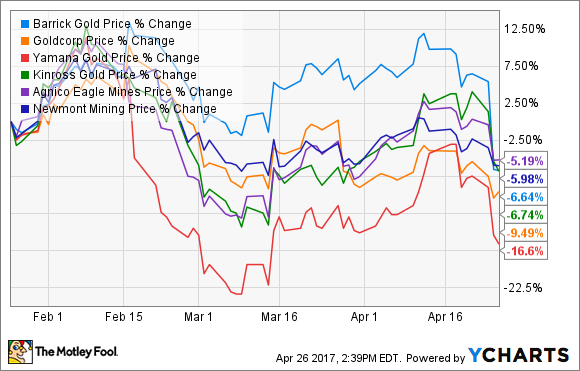This year is turning out to be a nerve-racking ride for gold stocks. Investors were hopeful of some positive triggers this earnings season, but Barrick Gold Corp. (ABX 0.05%) just sent shockwaves through the gold industry by missing consensus first-quarter estimates by a wide margin and downgrading its production outlook. Barrick's shares crashed by double digits on April 25 after the announcement, pulling most gold stocks along.
If you examine the three-month performances of some of the largest gold stocks today, you'll see how Yamana Gold (AUY +0.00%) and Goldcorp (GG +0.00%) have taken the biggest hits. Others, such as Newmont Mining (NEM +0.80%), Kinross Gold (KGC 0.38%), Barrick, and Agnico Eagle Mines (AEM 0.66%), are all down by single-digit percentages. Among these four gold stocks, though, Kinross has been hit the hardest in the past year.
So why have Yamana, Goldcorp, and Kinross shares been beaten up? Gold continues to remain a preferred safe-haven investment among investors during uncertain times, and gold prices, though a bit choppy, have been northward bound so far this year, still up about 8.6% year to date. Does that mean these three beaten-up gold stocks are bargains today? Let's find out.

Image source: Getty Images
Goldcorp: More pros than cons
Goldcorp stock was pounded in March, when it announced a 50/50 joint venture with Barrick to operate the latter's Cerro Casale mine in Chile. It's a complex deal under which Goldcorp will buy 25% stake in the mine each from Barrick and Kinross, paying $260 million to each company along with royalty interest and a contingent payment. Goldcorp will also acquire Quebrada Seca from Kinross -- half of which will be owned by Barrick – as well as Exeter Resource and its Caspiche project, located in the same Maricunga Gold Belt. These projects will eventually be part of the joint venture.
Investors are jittery over the complexities involved, the $800 million-plus price tag of the entire deal, and the fact that Caspiche is still in exploration phase. However, Cerro Casale is among the world's largest gold mines and will give Goldcorp exposure to 11.6 million ounces of gold. Goldcorp and Barrick already jointly operate the Pueblo Viejo mine, which is now Goldcorp's largest and lowest-cost mine. In other words, the two gold miners could potentially unlock substantial value from their new joint venture.
Goldcorp hasn't disappointed from an operational standpoint, either, having lowered its all-in-sustaining costs (AISC) by roughly 4% to $856 an ounce in fiscal 2016 and turning profits instead of losses in 2015. Goldcorp expects to cut AISC to $700 per ounce and increase gold production by 20% in the next five years.
Kinross Gold: Challenges aplenty
After starting the year on a strong note, Kinross shares came under pressure ever after the gold miner announced its fiscal 2016 results in mid-February. Kinross' losses narrowed dramatically, as there weren't any impairment charges last year, unlike in 2015, and it even turned profitable on an adjusted basis, backed by record production of nearly 2.8 million ounces.
But the markets weren't happy, for two reasons. First, Kinross' AISC came in at $985 per ounce, which was not only higher than 2015 but is also among the highest in the industry. Second, Kinross anticipates production to decline to 2.5 million to 2.7 million ounces this year. The miner's wide AISC range estimate of $925-$1,025 per ounce for the year isn't too encouraging, either, and it didn't provide a longer-term outlook.

Tasiast mine. Image source: Kinross.
Another huge factor dragging down Kinross' stock is its Tasiast mine, bought for a steep price of nearly $7 billion in 2010. Cost overruns and low production have forced Kinross to write down billions of dollars over the years. Things have, however, started rolling now, what with management expecting production at Tasiast to nearly double if it comes online under phase 1 expansion by Q2 2018 as planned. Meanwhile, phase two feasibility studies are already under way.
Yamana Gold: On the right path
Much like Kinross, Yamana shares have been weak ever since the miner's fiscal 2016 earnings announcement mid-February. While Yamana's revenues improved and net losses came down to $290.8 million in fiscal 2016 from $1.7 billion in 2015, its AISC (co-product basis) increased 7% to $911 per ounce. However, Yamana expects its AISC to improve slightly to $890-$910 per ounce this year.
Yamana's biggest catalyst going forward is commencement of production at its seventh mine, Cerro Moro, early next year. In Yamana's own words, "Cerro Moro is expected to be a significant contributor to cash flow as a result of the expected cash costs and AISC that are well below the company's current average cost structure." Yamana's gold production is expected to grow 10% by 2019. Meanwhile, the company is also striving to strengthen its balance sheet through a sale of its stake in its recently spun-off subsidiary Brio Gold to repay debt.
Foolish takeaway: Yamana is incredibly cheap
Now that you have a fair idea about what's going on at Goldcorp, Kinross, and Yamana, here's a final chart to help you decide if these stocks are bargains.
AUY Price to CFO Per Share (TTM) data by YCharts
While I'm most excited about Goldcorp's prospects, Yamana and Kinross are way cheaper, at under 4 times price-to-cash flow. Because Kinross' future still largely hangs on Tasiast, I'd put my money on Yamana now if I were to choose between these two stocks.












